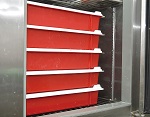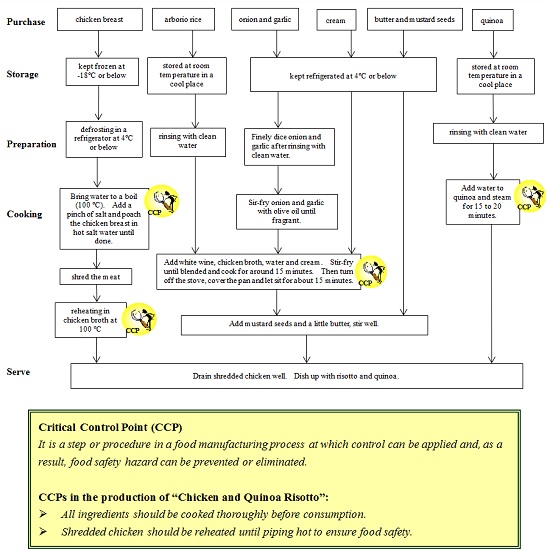
Feature Article
Know More About Aluminium-containing Food Additives
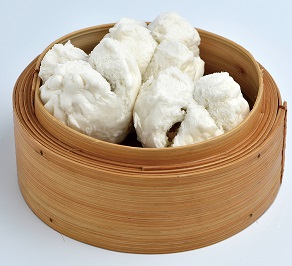
The Centre for Food Safety (“CFS”) had earlier announced a follow-up study of the first risk assessment study report on aluminium in food released in 2009. The study revealed that aluminium-containing food additives were widely used in certain food products available in Hong Kong, such as steamed bread/bun/cake, some bakery products like egg waffle and waffle, and ready-to-eat jellyfish
In fact, we cannot completely stay away from aluminium in our daily lives. Trace amounts of aluminium exist in the environment (air, water, soil and food) and are also found in household items. Nonetheless, aluminium present naturally in food is usually at very low levels. Our intake of aluminium is mainly through food ingestion, with aluminium-containing food additives being the main source of aluminium in the human diet. These food additives can be used as firming agents, raising agents, anti-caking agents, colouring matters, etc. According to the evaluation of the Joint Food and Agriculture Organization (“FAO”)/World Health Organization (“WHO”) Expert Committee on Food Additives (“JECFA”) on the safety of aluminium in 2011, the Provisional Tolerable Weekly Intake (“PTWI”) of aluminium was set at 2 mg/kg of body weight per week (bw/week).

The follow-up study revealed an extensive use of aluminium-containing food additives in certain food products offered for sale in Hong Kong. Among the seven food groups in the study, the food products found to contain relatively high concentrations of aluminium included “steamed bread/bun/cake” (mean: 65 to 280 mg/kg), some “bakery products” such as egg waffle and waffle (mean: 270 mg/kg), and ready-to-eat jellyfish (mean: 800 mg/kg), which had the highest mean aluminium concentration among the 36 food items collected. There is no conclusive evidence that aluminium compounds exhibit carcinogenic potential in humans or are associated with Alzheimer's disease. However, some animal studies have indicated that aluminium compounds may have developmental toxicity effects.
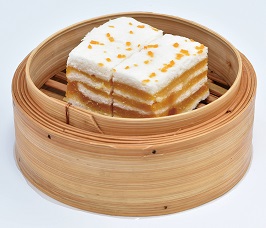
The study estimated that the dietary exposures of average and high consumers of the population to aluminium were 0.49 mg/kg bw/week and 1.80 mg/kg bw/week respectively, accounting for 25% and 90% of the PTWI established by the JECFA. Based on these results, the general population was unlikely to experience major undesirable health effects of aluminium through food consumption. Nevertheless, for consumers with brand loyalty to products with high aluminium contents, the health risks of exposure to aluminium would be increased.
Comparing the results of the current study with that of the previous study, a decrease in the mean aluminium concentration was found in 59% of the food items. More food items showed a decrease in the mean aluminium concentration within the same food group, except “steamed bread/bun/cake”
The wide variation of aluminium concentrations in the samples within the same type of food items indicated that it was possible to minimise aluminium-containing food additives in food production. The CFS has been working closely with the industry to reduce the dietary exposure of the public to aluminium and has formulated the “Guidelines on the Use of Aluminium-containing Food Additives” for the trade. The Guidelines were revised in November 2016. The CFS advised the trade to take the Guidelines into consideration and implement the recommendations where appropriate to reduce the aluminium content of their products.
Advice to the Public
- Aluminium-containing food additives should be reduced or replaced with other alternatives in food preparation as far as possible.
- Maintain a balanced diet to avoid excessive exposure to aluminium from a small range of food items.
- When purchasing prepackaged food products, refer to the ingredient lists on the food labels for information on whether aluminium-containing food additives have been added.
Readers’ Corner
Safety Concerns About Siu-mei
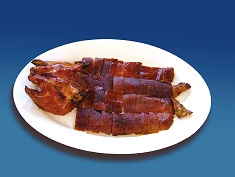
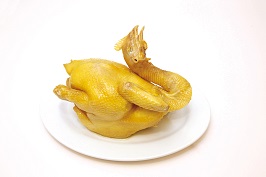
Siu-mei is a local delicacy which enjoys great popularity in Hong Kong. It is a food you often see on the dining table when office workers are having a meal, when people are preparing dinner at home, or when you are at a banquet. Siu-mei is the Cantonese name given to meat products that have been roasted at 200˚C or above. It is mainly made from pork and poultry meat. The most common examples include roasted pork, BBQ pork and roasted ducks and geese. As siu-mei is handled a lot during production and is usually displayed for sale at room temperatures at the retail outlets, it is liable to food poisoning due to pathogen contamination and bacterial growth.
Hot summer months are a high-risk period of bacterial food poisoning since bacteria grow more rapidly in warm environments. The CFS would like to remind the public to stay vigilant particularly during summer times to ensure food safety.
Advice to Consumers
- Buy food from reliable shops that observe good hygiene practices.
- Observe whether food handlers follow good personal hygiene. They should not be smoking, playing with their hair or having any open wounds
- Observe whether raw food is placed in the siu-mei and lo-mei (marinated food prepared by simmering in a soy-based sauce) showcase.
- Observe whether the siu-mei and lo-mei are covered or displayed in an insect- and dust-proof showcase.
- Consume the siu-mei and lo-mei as soon as possible after purchase.
- Store the leftovers in a refrigerator and reheat them thoroughly before consumption.
Dioxins and Dioxin-like Polychlorinated Biphenyls in Hairy Crabs
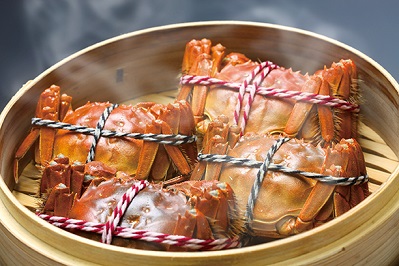
Samples of hairy crabs imported from the Mainland were earlier found to contain carcinogenic dioxins and dioxin-like polychlorinated biphenyls (“DL-PCBs”) exceeding the CFS’ action level of 6.5 pg toxic equivalent (“TEQ”) per gram of the food sample (wet weight) for the sum of dioxins and DL-PCBs.
Dioxins and DL-PCBs can affect a number of human body systems, including the endocrine and immune systems and the developing nervous system. They are also linked with an increased risk of cancer. The International Agency for Research on Cancer has classified dioxins and DL-PCBs as human carcinogens.
Dioxins and DL-PCBs are a group of environmental pollutants which are highly resistant to chemical and biological degradation. These substances are ubiquitous in the environment, arising either naturally (e.g. from volcanic eruptions or forest fires) or as by-products of industrial activities (e.g. metal smelting, moulding and burning of chlorinated organic chemicals like plastics).
Since dioxins and DL-PCBs are fat-soluble, they tend to accumulate in fatty tissues. Fatty foods including meat, milk, eggs and seafood are the major source of human dietary exposure to dioxins and DL-PCBs. For aquatic animals, some body parts such as fish livers and internal organs of crabs like roes and hepatopancreas (referred to as the brown meat) naturally have a greater fat content, and may contain a higher amount of dioxins and DL-PCBs.
In December 2011, the CFS released the first report under the First Hong Kong Total Diet Study. The report, which studied dioxins and DL-PCBs in food, concluded that the dietary exposures to dioxins and DL-PCBs were 21.92 and 59.65 pg TEQ/kg bw/month for average and high consumers of the population respectively, both lower than the Provisional Tolerable Monthly Intake (i.e. 70 pg TEQ/kg bw/month) established by the JECFA in 2001. As such, the general population was unlikely to experience major undesirable health effects of dioxins and DL-PCBs.
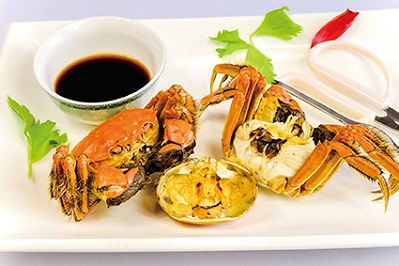
Hairy crabs occur in streams, rivers and lakes. They scavenge the bottom of their habitats for food. When dioxins and DL-PCBs are released close to their habitats, hairy crabs may contain dioxins and DL-PCBs due to consumption of polluted soils and aquatic sediments.
The edible portion of hairy crabs can broadly be divided into the white meat and the brown meat. The white meat is white in colour and comes from the claws, legs and the body. The brown meat, consisting chiefly of the crab’s digestive and reproductive organs, is brownish-green and obtained from the main body (the cephalothorax). As the brown meat is higher in fat than the white meat, the lipophilic dioxins and DL-PCBs are more likely to accumulate in the brown meat.
In Hong Kong, the current legislation has no prescribed standards for dioxins and DL-PCBs in food. However, section 54 of the Public Health and Municipal Services Ordinance (Cap. 132) provides that all food for sale and intended for human consumption must be fit for this purpose. To ensure that hairy crabs for sale in Hong Kong comply with the statutory requirements and are suitable for human consumption, the CFS will continue to take samples for testing (including dioxins and DL-PCBs) at the import, wholesale and retail levels. The health certificates accompanying hairy crab imports will also be checked.
Following the incidents of hairy crabs detected with dioxins and DL-PCBs at the end of 2016, the CFS met the trade in January and June 2017 to exchange views on dioxin monitoring in food and the import arrangements for hairy crabs. The CFS will also maintain liaison with the Mainland inspection and quarantine authorities to ensure hairy crabs supplied to Hong Kong are fit for human consumption for the protection of public health.
Advice to Consumers
Due to the omnipresence of dioxins and DL-PCBs in the global environment, all people have background dietary exposure, which is not expected to affect human health. Nonetheless, the WHO opines that lowering the level of dioxins and DL-PCBs in the body (the body burden) is a long-term strategy and is probably most relevant for girls and young women to reduce dioxin exposure in fetuses and when breastfeeding infants later on in life.
- Trimming fat from meat and consuming low-fat dairy products may decrease exposure to dioxins and DL-PCBs.
- A balanced diet (including adequate amounts of fruits, vegetables and cereals) will help to avoid excessive exposure from a single source.
- Consume hairy crabs in moderation.
News on New Dishes
Chicken and Quinoa Risotto

In recent years, continued efforts have been devoted by the FAO of the United Nations to encourage the consumption of quinoa, a nutrient-rich crop good for health. Quinoa is one of the top ten wholesome and nutrition-packed foods in the world. Here in Hong Kong, a growing number of people have added quinoa to their recipes. In this issue, Mr Eric LAM, chef of “Something Wild - The Farm”, a signatory of the Food Safety Charter, will give a cooking demonstration on “Chicken and Quinoa Risotto”. Mr LAM has more than ten years of experience in offering cuisines from different countries. In the following, he will show us how this quinoa dish is prepared.
| Preparation Steps | Small Tips, Big Wisdom | |
|---|---|---|
|
Receiving
|
Purchase the ingredients such as frozen chicken breast, quinoa, arborio rice, onion, garlic, white wine, mustard seeds and cream from approved and reliable suppliers. Finely dice onion and garlic after rinsing with clean water. | Check the ingredients carefully upon receipt to ensure their freshness. Keep cream under refrigeration at 4ºC or below, and frozen chicken breast at -18ºC or below. Place the other ingredients on shelves in an orderly manner. Make sure that foods are consumed within their shelf life. Stick to the “first-in-first-out” principle and use the oldest stocks with the shortest shelf life first. |
|
Defrosting
|
Thaw the frozen chicken breast in a refrigerator at 4ºC or below. | Thawing in a refrigerator at 4ºC or below not only ensures food safety but also preserves the flavour of chicken meat. |
|
Poaching
|
Put the defrosted chicken breast into hot salt water. Poach until done. Shred the meat, prepare the chicken broth, and set aside. | Cook the chicken breast thoroughly to an internal temperature of 75ºC for at least 30 seconds to destroy pathogens. |
|
Steaming
|
Add water to quinoa (1:1), steam for 15 to 20 minutes and set aside. | |
|
Cooking
|
Stir-fry onion and garlic with olive oil until fragrant. Add in arborio rice, white wine, chicken broth, water and cream. Stir-fry until blended and cook for around 15 minutes. Then turn off the stove, cover the pan and let sit for about 15 minutes. Add mustard seeds and a little butter, stir well. Lastly, reheat shredded chicken in boiling broth, drain well and dish up with risotto and quinoa | If food is not consumed within the same day after heating, it should be cooled as quickly as possible and properly refrigerated to prevent the multiplication of Bacillus cereus. |
Tips from Mr LAM:
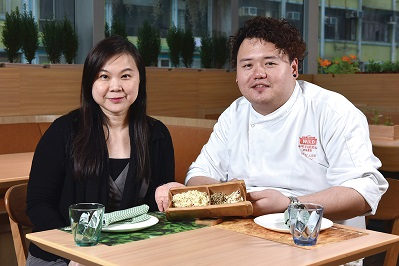
- Poach the chicken breast to an internal temperature of 75 ºC, then turn off the stove, cover the pan, and let sit for a while to keep the meat tender.
- The steaming time for quinoa may vary according to personal preferences.
- Avoid making risotto too early to minimise pathogenic hazards.
Food Safety Plan Corner
Chicken and Quinoa Risotto
Ingredient:
Chicken breast, quinoa, arborio rice, onion, garlic, cream, butter, mustard seeds and olive oil
Steps:
- Allow the chicken breast (frozen at -18ºC) to defrost in a refrigerator at 4ºC or below.
- Take out the ingredients refrigerated at 4ºC or below. Finely dice onion and garlic after rinsing with clean water.
- Put the defrosted chicken breast into hot salt water. Poach until done. Shred the meat, prepare the chicken broth, and set aside.
- Add water to quinoa (1:1), steam for 15 to 20 minutes and set aside.
- Stir-fry onion and garlic with olive oil until fragrant. Add in arborio rice, white wine, chicken broth, water and cream. Stir-fry until blended and cook for around 15 minutes. Then turn off the stove, cover the pan and let sit for about 15 minutes. Add mustard seeds and a little butter, stir well.
- Reheat shredded chicken in boiling chicken broth until piping hot. Drain well and dish up with risotto and quinoa.
Production Process
Briefing of Activities
Food Hygiene Talks
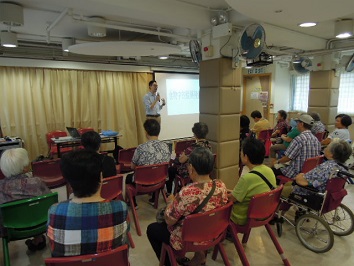
The CFS enhances food safety by spreading food safety and food hygiene messages to the public through a host of channels. For instance, health inspectors of its Communication Resource Unit (“CRU”) give food hygiene/food safety talks in schools and community centres to share food-related knowledge with the participants, thereby heightening public awareness of food safety and promoting healthy eating habits.
The CRU regularly issues letters to primary and secondary schools to introduce the various themes of their food hygiene talks, such as “Nutrition Labelling”, “Food Poisoning”, “5 Keys to Food Safety”, “Natural Toxins in Food”, “Veterinary Drug Residues in Food” and “Genetically Modified Food”. Interested schools can reply and make an appointment. The CRU will then arrange for health inspectors to deliver a talk in the school and distribute leaflets and other publicity materials to the students.
Upcoming Activities
Food Safety Day 2017
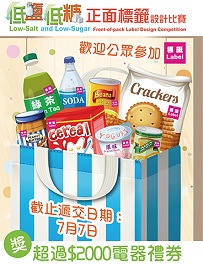

The Food Safety Day is an annual signature event of the CFS. The theme this year is “Hong Kong's Action on Salt and Sugar Reduction: Read Labels, Choose Smartly”. To echo the theme, the Committee on Reduction of Salt and Sugar in Food (“CRSS”), the Food and Health Bureau (“FHB”), the CFS of the Food and Environmental Hygiene Department, the Department of Health (“DH”) and the Education Bureau (“EDB”), with the support of the Committee on Home-School Co-operation, are jointly organising the “Smart Choices for Low-Salt and Low-Sugar Slogan Writing cum Poster Design Competition”. In addition, the “Low-Salt and Low-Sugar Front-of-pack Label Design Competition” is being launched by the CRSS, the FHB, the CFS and the DH. The award presentation ceremonies of the two competitions are scheduled for 20 October 2017 (Friday) at Lecture Theatre, 4/F, West Block, EDB Kowloon Tong Education Services Centre. Through these competitions, it is hoped that healthy eating can become popular and the public can reduce dietary intake of salt and sugar with the use of nutrition labels. To view details of the competitions and the online voting results, please visit the CFS website at www.cfs.gov.hk.
In relation to the above, a series of talks will be conducted for the public and the trade. All interested parties are welcome. Please check the CFS website for the dates, venues and details of the talks.
Food Safety Q&A
How to Reduce the Risk of Producing Carcinogens When Stir-frying Vegetables?
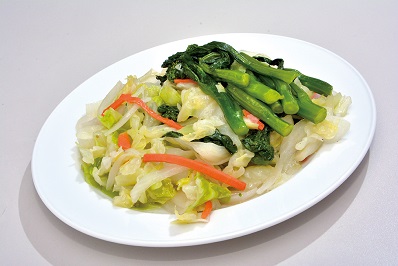
A girl has just returned home from school for lunch. Her grandmother is about to dish up.
Girl: Granny, I’m home!
Granny: Your school day has finished, sweetie? We’re having Three Stuffed Treasures (pan-fried eggplants, bell peppers and bean curds stuffed with minced dace) and fried choi sum with beef for lunch today. These are your favourites.
Girl: Granny, I won’t eat Three Stuffed Treasures anymore.
Granny: Why?
Girl: I learnt this from my teacher today. When food is cooked or processed at high temperatures (usually above 120°C), a carcinogenic chemical called acrylamide will be formed in food. If we eat a lot of deep-fried/baked foods, it can increase the risk of cancer. So, …
Granny: Oh! Actually I attended a talk in a community centre before and know something about acrylamide. To reduce acrylamide in food, we should not cook food at temperatures too high for a prolonged time. But you can eat my Three Stuffed Treasures without worries! After stuffing the eggplants, green bell peppers and bean curds with minced dace, I steamed them until done. Then I pan-fried the stuffed side over medium-low heat until fragrant. Finally, I poured the black pepper sauce onto the food. In this way, I could avoid pan-frying the food for too long or at too high a temperature. The dish not only tastes good but is also safe for consumption.
Girl: Wow, it smells delicious!
The grandmother is serving the two dishes.
Granny: Stir-frying vegetables at high temperature will also cause acrylamide. Though stir-frying at high heat can bring out “wok-hei” (the flavour and tastes imparted by a hot wok on food), it’s not the healthy way to prepare food. That’s why I blanched the vegetables in advance to avoid frying them at too high a temperature for too long a time. This could help reduce acrylamide in the frying process. The blanched choi sum was stir-fried briefly until done. Then I added in pre-cooked beef slices and stirred well. See? This is your all-time favourite dish ─ fried choi sum with beef, in Granny’s style.
The girl picks up the bowl and chopsticks and starts eating with great relish.
Girl: Granny, you are terrific!
Granny: I love you so dearly, sweetie. I must make sure that you eat happily and healthily. In fact, it’s not difficult to do so. Just a bit of brain work and a change of cooking habits will do. Other than pan-frying, stir-frying and deep-frying, we may consider boiling and steaming more. Sometimes, instead of fried vegetables, we can prepare a cold dish or a salad with fresh and washed vegetables like lettuce, cucumber and tomato. We can eat fresh and stay healthy.
Girl: I love you, Granny!
Truth against Fallacy
Will I Be Infected by Avian Influenza After Eating Chicken?
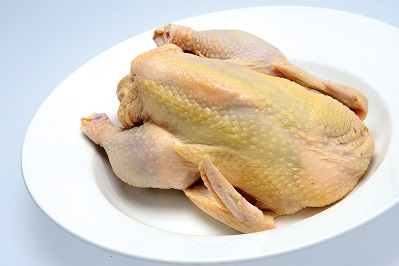
Ming: A new Korean restaurant has opened in the neighbourhood. My friend said its fried chicken tasted really good. Want to try it out tonight?
Pat: We’d better not eat chicken. Not long ago, I read net pals’ messages saying that people died of H7N9 avian flu infections after eating chicken meat, chicken feet and stuff like that. It’s scary!
Ming: Pat, the Internet is flooded with information. You should verify the contents of the messages when you receive them. Don’t believe everything you read on the Internet readily. It’s true that raw poultry meat and poultry eggs may be contaminated with bacteria or viruses such as Salmonella spp. or avian flu viruses, but the bacteria and viruses can be eliminated by thorough cooking. This can significantly reduce the risk of contracting avian flu through consumption of these foods. The WHO has also pointed out human infections with avian flu are primarily acquired through direct contact with infected animals or exposure to contaminated environments. There is no evidence that avian influenza viruses can infect humans through properly cooked food.
Pat: I see! But earlier there were news reports about outbreaks of avian flu in many different places. How can I prevent infection with the virus?
Ming: The key is to observe good personal, food and environmental hygiene at all times. We can also refer to the safety tips from the CFS:
- Avoid touching poultry/birds or their faeces.
- Avoid touching chickens or their faeces when buying live chickens. Do not blow their vent.
- Remember to wash hands properly with soap or liquid cleanser after handling live poultry, poultry products or poultryeggs. All the working surfaces, utensils and equipment that have been used for handling the above should also be cleaned thoroughly.
- Handle and store raw food and ready-to-eat food separately to prevent cross contamination.
- Cook poultry eggs fully until the white and the yolk are firm. Do not eat raw eggs or any sauce mixed with raw eggs.
- Cook poultry thoroughly before consumption. If pinkish juices run from the cooked poultry or the middle parts of the bones are still red in colour, cook the poultry again until fully done.
Moreover, we should wash our hands frequently and wear a face mask if we have developed a fever or respiratory infection symptoms.
Pat: Got it! Let’s try the mouth-watering fried chicken tonight!
Brain Gym
Multiple Choice Questions
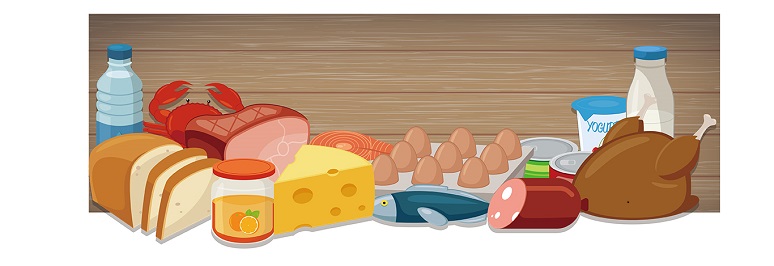
-
Which of the following chemicals will be easily produced during high-temperature cooking of carbohydrate-rich food?
- Dioxins
- Acrylamide
- Aflatoxins
- Nitrite
-
Which of the following practices cannot effectively reduce the risk of food poisoning in relation to consumption of shellfish?
- Buy shellfish from recognised and reliable shops.
- Remove the viscera and gonads of shellfish before cooking.
- Use ingredients such as wine, vinegar, garlic and/or chilli to marinate fresh shellfish prior to direct consumption.
- Cook shellfish in boiling water until their shells fully open, and boil for an additional 3 to 5 minutes.
-
Which of the following is not a feature of Listeria monocytogenes?
- It can survive and multiply at temperatures as low as 0°C.
- It is universally found in the environment, particularly in soils, vegetation, animal feeds, and in human and animal faeces.
- It cannot be destroyed under normal cooking temperatures
- The passage of Listeria monocytogenes through the placenta may cause miscarriage, stillbirth, premature birth or meningitis in the newborns.
-
Which of the following is the most common foodborne pathogenic bacteria found on the skin and in the nasal cavity, hair and wounds of human bodies?
- Staphylococcus aureus
- Salmonella spp
- Vibrio parahaemolyticus
- Clostridium perfringens
Answers: 1.(b) 2.(c) 3.(c) 4.(a)
Enquiries and Subscription
Printed copies of the Food Safety Bulletin can be obtained from the Communication Resource Unit at 8/F, Fa Yuen Street Municipal Services Building, 123A Fa Yuen Street, Mong Kok, Kowloon. For enquiries, please call 2381 6096. The public may also visit the CFS website ( www.cfs.gov.hk ) for the online version.
Enquiry hotline 2868 0000
E-mail address enquiries@fehd.gov.hk
CFS website www.cfs.gov.hk.
